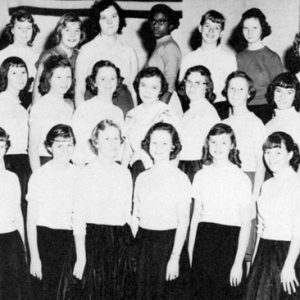calsfoundation@cals.org
Desegregation of Hoxie Schools
During the summer and autumn of 1955, proponents and opponents of school integration across America were watching what Cabell Phillips of the New York Times called “a battle in a test tube.” The scene of the “battle” was Hoxie (Lawrence County), a small community in the northeastern part of Arkansas. Phillips’s dispatches turned the isolated rural town into a focal point for the nation. While not the earliest instance of desegregation in the state—Fayetteville (Washington County) and Charleston (Franklin County) were peacefully integrated the previous year—Hoxie’s attempt was the first to be met with active resistance.
In 1955, Hoxie, with its population of 1,855 residents, was a collection of one- and two-story structures strung along the tracks of the Missouri Pacific and the St. Louis–San Francisco (Frisco) railroads. Hoxie schools followed the practice of splitting the fall school term to allow pupils to pick cotton in late September and October. There was one poorly maintained elementary school for fewer than thirty African-American children, while those of high school age were bused to an all-black school in Jonesboro (Craighead County). School was scheduled to begin on July 11, 1955, and in accordance with a unanimous vote by the school board, the Hoxie School District, believing it did not have the funds to maintain separate schools, moved to abolish its dual educational system by integrating black children into its previously all-white schools, made up of approximately 1000 white children. Twenty-five black children initially registered; however, several dropped their enrollment, leaving twenty-one students to attend on the first day of classes. The superintendent of schools, Kunkel Edward Vance, had given three reasons for integration: it was “right in the sight of God,” it complied with the Supreme Court ruling in Brown v. Board of Education of Topeka, Kansas, and it saved money. Vance said all school facilities would be integrated, not just the classrooms, and on the morning of July 11, 1955, the black children came to the white Hoxie schools. No incidents occurred on the first day of integration, and from initial appearances, Hoxie was a successful effort at school integration in Arkansas. On Monday, July 25, 1955, however, the situation changed as the latest issue of Life magazine appeared on newsstands across America. The intent of Life’s pictorial essay was to recognize a small Southern community’s efforts toward compliance with the law. The effect, however, was a spotlight on Hoxie, which attracted the vocal ire of segregationists in the community, and soon in the state and region.
On August 3, 1955, approximately 350 segregationists from the local area gathered in Hoxie City Hall to protest the desegregation of Hoxie schools. They passed a resolution vowing not to patronize or support the Hoxie schools, and a boycott of the schools began the next day. Segregationists announced that half of the white student population remained at home, although Superintendent Vance, while not issuing the actual figures, disputed that claim. The situation in Hoxie gained attention elsewhere as segregationists throughout Arkansas viewed integration in Hoxie as a test and prepared for confrontation with the Hoxie School Board, which remained resolute in its decision to integrate. The first outsiders came to Hoxie on August 13, 1955, when the Little Rock (Pulaski County) chapter of White America sent two representatives to a segregationist rally in Hoxie. At that rally, a petition with more than 1000 signatures was presented requesting the resignation of all five members of the school board. The board members did not resign and voted to stand by their original decision. The Walnut Ridge (Lawrence County) newspaper serving Hoxie, the Times Dispatch, stated in its August 18 edition, “Hoxie battle lines drawn as both sides stand firm in integration dispute.”
Arkansas governor Orval Faubus informed the Hoxie School Board that the state government would not intervene there or in any school district. The refusal of the state government to become involved was a blow to the school board, which was looking for support as outsiders came to Hoxie from other Arkansas towns and from other southern states. Even in the face of outside influences, the majority of Hoxie’s citizens, both black and white, refused to respond to any racial harassment and waited for a peaceful resolution of the issue. Fortunately, harassment remained only vocal, and it was limited. Confrontation between the school board and the segregationists moved to the courtroom.
The Hoxie School Board forced the issue of racial integration into the courts by filing suit against the segregationist leaders both from Hoxie and elsewhere in the state. The complaint alleged that operation of integrated schools was effective until the defendants began to challenge the board’s action. The school officials charged the segregationists, in their efforts to thwart integration in Hoxie, with trespassing on school property, threatening picket lines, organizing boycotts, and intimidating school officials. In November 1955, Federal District Judge Thomas C. Trimble ruled that pro-segregation forces had “planned and conspired” to prevent integration in Hoxie, and he issued a temporary restraining order against the segregationists. A hearing to make an injunction against the segregationists permanent was held in December 1955. The court ruled that the school board could have been criminally and civilly liable if it had failed to integrate and that a permanent injunction against the segregationists was in order. The day after the decision, Vance resigned, admitting the integration crisis played a large part in his decision.
The segregationists appealed the decision to the Eighth Circuit Court of Appeals. The U.S. Department of Justice, through the office of Attorney General Herbert Brownell, entered the case on the side of the Hoxie School Board. This was the first intervention by the attorney general in support of any school district trying to comply with the Supreme Court decision in Brown v. Board of Education. On October 25, 1956, the court ruled in favor of the Hoxie School.
The segregationists’ setback at Hoxie was a turning point in their efforts to prevent integration in Arkansas. Because efforts to pressure the school board had failed, the strategy of segregationists changed. No longer would school boards be the primary target, but rather Arkansas politicians. Certainly, the events surrounding the desegregation of Little Rock Central High School in 1957 serve as the prime example. Governor Faubus, rather than the local school board, was thrown into the spotlight of national and world attention and succumbed to segregationist pressure. However, just as in Hoxie, the segregationists’ strategy, in all its forms, ultimately failed.
For additional information:
Appleby, David, producer. Hoxie: The First Stand. PBS Documentary. 2003.
Benton, Daniel Andrew. “Segregationist Organizations and the Promotion of Violence during the Hoxie and Little Rock Crises of 1955 and 1957.” MA thesis, University of Arkansas at Little Rock, 2009.
Harris, Rodney W. “A Town Divided: Leadership at Hoxie.” Ozark Historical Review 42 (Spring 2013): 117–128.
“The Integration of Hoxie: A Panel Discussion.” Arkansas Review: A Journal of Delta Studies 35 (December 2004): 188–203.
Peltason, J. W. Fifty-Eight Lonely Men. New York: Harcourt, Brace & World, Inc., 1961.
Phillips, Cabell. “Integration: Battle of Hoxie, Arkansas.” New York Times Magazine 25 (September 1955): 12.
Vervack, Jerry. “Road to Armageddon: Arkansas and Brown v. Board of Education, May 17, 1954, to September 2, 1957.” MA thesis, University of Arkansas, 1978.
———. “The Hoxie Imbroglio.” Arkansas Historical Quarterly 48 (Spring 1989): 17–33.
Jerry Vervack
Northwest Arkansas Community College
 Hoxie Glee Club
Hoxie Glee Club  Ethel Tompkins
Ethel Tompkins 




I was in the eighth grade when Hoxie integrated. It was great finding this article and reading the history. As an eighth-grader, I of course only knew and remembered some of this. I remember the men coming to our house and wanting my grandfather to agree not to send me to school. But he and I agreed that I was going to go to school. I remember telling him that he had always taught me that everyone is equal, so why wouldn’t I want to go to school with the black students? I remember after the first week of school that there didn’t seem to be any more “problems.” I’m glad to read the “real” facts of our integration story. I never knew we played the role we did in the early history of integration of schools until about ten years ago when I discovered the documentary Hoxie: The First Stand. My name as a student was Mary Sue Morris.